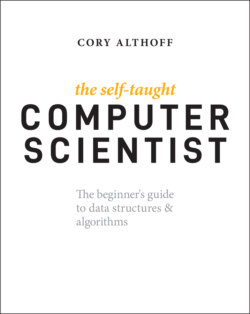Читать книгу The Self-Taught Computer Scientist - Cory Althoff - Страница 18
1 What Is an Algorithm?
ОглавлениеWhether you want to uncover the secrets of the universe or you just want to pursue a career in the 21st century, basic computer programming is an essential skill to learn.
Stephen Hawking
An algorithm is a sequence of steps that solves a problem. For example, one algorithm for making scrambled eggs is to crack three eggs over a bowl, whisk them, pour them into a pan, heat the pan on a stove, stir them, and remove them from the pan once they are no longer runny. This section of the book is all about algorithms. You will learn algorithms you can use to solve problems such as finding prime numbers. You will also learn how to write a new, elegant type of algorithm and how to search and sort data.
In this chapter, you will learn how to compare two algorithms to help you analyze them. It is important for a programmer to understand why one algorithm may be better than another because programmers spend most of their time writing algorithms and deciding what data structures to use with them. If you have no idea why you should choose one algorithm over another, you will not be a very effective programmer, so this chapter is critical.
While algorithms are a fundamental concept in computer science, computer scientists have not agreed on a formal definition. There are many competing definitions, but Donald Knuth's is among the best known. He describes an algorithm as a definite, effective, and finite process that receives input and produces output based on this input.
Definiteness means that the steps are clear, concise, and unambiguous.
Effectiveness means that you can perform each operation precisely to solve the problem.
Finiteness means that the algorithm stops after a finite number of steps.
A common addition to this list is correctness. An algorithm should always produce the same output for a given input, and this output should be the correct answer to the problem the algorithm solves.
Most, but not all, algorithms fulfill these requirements, and some of the exceptions are important. For example, when you create a random number generator, your goal is to generate randomness so someone can't use the input to guess the output. Also, many algorithms in data science are not strict about correctness. For example, it may be sufficient for an algorithm to estimate output, as long as the estimate's uncertainty is known. In most cases, however, your algorithms should fulfill all the previous requirements. If you write an algorithm for making scrambled eggs, the user might not be happy if, occasionally, the algorithm produces an omelet or boiled eggs instead.
